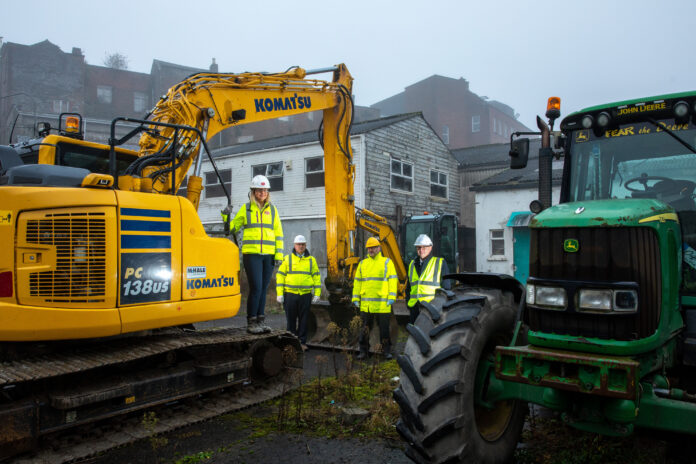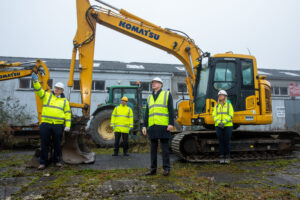
LIMERICK’S biggest single commercial property investment and largest ever outside Dublin got underway on Monday at the city centre Opera Site.
Demolition and enabling works were started by John Sisk & Son Ltd at the 1.62 hectare site that will have the capacity for up to 3,000 employees across a 450,000 sq ft campus.
The €200 million programme will take up to six years to complete, with up to 500 people involved in construction at peak.
Among the key elements of the project will be a 14-storey office building; a five-storey aparthotel with retail units on ground and basement levels; an over-basement office building with retail units and a restaurant/café; a new library and significant public realm space.
The site is being developed by Limerick Twenty Thirty (LTT), a special purpose vehicle established by Limerick City and County Council in 2016 to stimulate economic and social development by building out and promoting strategic disused sites in Limerick.
LTT has already completed the award-winning and fully let Gardens International project on Henry Street which was completed at a cost of €17.6m.
Also included in its portfolio is Troy Studios, Castletroy, which is fully completed and let; the ten acre Cleeves Riverside Project which is currently at master-planning stage; and the 60 acre Mungret Park residential site where a 200 unit first phase will go to planning early next year.
The Opera Site is fully funded by the European Investment Bank, the Council of Europe Development Bank and the Department of Housing.
Having achieved planning in February 2020, the demolition and enabling works programme were commenced today by contractor John Sisk & Son Ltd at the 1.62 hectare site that will, when fully developed, have the capacity for up to 3,000 employees across a 450,000 sq ft campus accommodation.
The site is being developed by Limerick Twenty Thirty DAC (LTT), a special purpose vehicle established by Limerick City and County Council in 2016 to stimulate economic and social development by building out and promoting strategic disused sites in Limerick.
Photo: Sean Curtin True Media
The extensive site demolition and enabling works will take up to 12 months to complete as will the demolition of all 20th century buildings and later additions, the adaptive re-use of the Protected Structures and other structures of heritage value.
Three major site developments will take place in addition to the extensive enabling and demolition works over the first three years of the programme, including the new city library; aparthotel, retail and apartments and the Revenue Building and Granary developments.
Mayor Michael Collins said that the Opera Site development would be be crucial in helping Limerick springboard out of its broad economic challenges.
Minister of State with responsibility for Office of Public Works Patrick O’Donovan said the development would propel the Limerick economy into a new era.
“It’s going to accelerate the social advancement of the city. It’s also going to have a very positive ripple effect for a long time to come and way beyond the city but out into the county and into the region. I’m looking forward to that impact taking hold,” he added.
LTT chief executive David Conway said there would be a very significant employment and economic spin-off for the region in the six-year build programme.
‘We have been mandated to develop sites that would accelerate the ongoing transformation of Limerick City and today as we begin works here is a great moment in that journey.”
Limerick City and County Council chief executive Pat Daly said that the Opera Site had been the most talked about development in Limerick in modern times so they were delighted, together with Limerick Twenty Thirty, to make it happen.
“Limerick Twenty Thirty was designed to stimulate growth in Limerick and the Opera Site is the biggest project in the programme and the timing could not be better. Every city and region beyond in the world is in the grip of the economic fall-out from Covid-19 but the Opera site will give us a real edge in recovery,” he predicted.
Limerick Chamber chief executive Dee Ryan described the start of work on the site as a huge boost to Limerick.
“It will be an invitation to FDI, to indigenous business to look at Limerick. Once they do, they will see a city very much open for business, forward thinking and a great place to work and live.
“Even if the world of work is changing, there is still going to be a requirement for office commercial space and the beauty of the Limerick offering is that we can offer that at world-class standards but very competitively priced in a great city and region to work and live in,” she said.
Transforming the city’s streetscape
The Opera Site development will include a number of significant changes to the city streetscape.
The main elements will be a 14-storey building at Bank Place incorporating 13,264 sq metres of office floorspace.
A four to six storey over-basement building, with 12,654 sq metres of office space, 960 sq metres retail and 430 sq metres restaurant/café use at ground level
A five-storey building on the corner of Patrick Street and Ellen Street comprising of a 5,000 sq metres apart-hotel,13 apartments and over 1,000 sq metres of retail at ground and basement levels
A refurbished four-storey over-basement building on Rutland Street providing 444 sq metres of ground and basement retail use, with three residential dwellings above.
The refurbishment of 9 Ellen Street, formerly Quinn’s Bar, will provide a 1,260 sq metres bar and restaurant.
The renovation and adaption of the former Town Hall, including the construction of a six-storey over-basement extension, will provide a new public library of 4,515 sq metres; 2,981 sq metres of office space as well as 196 sq metres and 445 sq metres of café/restaurant floorspace in the basement.
The Bruce House Doorway will be relocated at the internal gable of number 8 Rutland Street within the new library building atrium while the Granary Buyilding on Michael Street will undergo extensive refurbishment.
A basement car park at Opera Square will also include car charging stations, secure cycle parking spaces, together with shower and changing facilities with additional secure cycle parking spaces at ground level.








